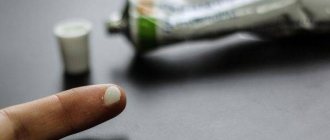pharmachologic effect
Furazolidone is a synthetic derivative of 5-nitrofurfural. It has the most active effect against gram-negative bacteria. Gram-positive cocas are less sensitive to it. Anaerobic pathogens are not at all sensitive to the drug.
The pharmacological effect of the drug on the human body directly depends on the dose taken: if the dose is insignificant, the drug will have a bacteriostatic effect. And at a large dose it is bactericidal.
What is the antimicrobial effect of the active substance? Nitro groups that are part of Furazalidone molecules under the influence of microbial enzymes are reconstructed into amino groups, which in turn are very toxic to cocci.
Amino groups destroy the solidity of the bacterial cell membrane, and the chemical processes occurring inside it are blocked. As a result, microorganisms are not capable of further reproduction and development.
Furazolidone has minor immunostimulating properties.
Resistance to the drug in bacteria develops very slowly.
The substance is excreted from the body mainly by the kidneys: partly in unchanged form, partly in the form of metabolites.
Symptoms and treatment of intestinal colitis in adults. Useful recommendations.
Instructions for use for the drug Cerucal can be found here.
Description of Furazolidone
Furazolidone is a derivative of nitrofurans. The properties of the drug are due to the ability of the active substance to disrupt the respiration processes in the cells of the microorganism, as well as inhibit the synthesis of nucleic acids (DNA).
When exposed to nitrofuran antibiotics, the pathogens release significantly less toxins into the bloodstream, so there is an improvement in the general well-being of the patient long before the entire population of microbes is destroyed. In addition, Furazolidone activates the immune system.
The medicine is active against Trichomonas, Giardia, Shigella, Salmonella. Resilience develops slowly.
Indications for use
The drug is prescribed if the following diseases are diagnosed:
- Infections of the digestive system of various origins;
- Infectious diseases of the urinary system;
- Typhoid, paratitis;
- Food poisoning.
- Giardiasis.
- Infectious diseases of the reproductive organs.
- Trichomonas colpitis.
- Inflammation of the urethra.
- Infectious lesions of the skin.
- Bacillary dysentery.
- Enterocolitis.
- Infectious diarrhea.
- Trichomonas vaginitis, cystitis.
- The product (in the form of a solution) is used to wash wounds and burns.
How to use?
The pill should be taken orally as a whole, never chew it, and wash it down with plenty of regular drinking water.
- Food poisoning, dysentery and paratyphoid – 4 times a day, 100 – 150 mg for 7 – 10 days.
- Colpitis, trichomonas infection - 3 - 4 times a day, 100 mg - for 3 days. In addition, 5 grams of powder with lactose (ratio 1: 400) should be administered inside the vagina once a day, and suppositories with Furazolidone should be administered into the rectum.
- Trichomonas urethritis - 100 mg of the substance - 4 times a day for 3 days.
- For the treatment of giardiasis – adults – 4 times a day – 100 mg, children – you need to take 10 mg of the substance per kg of child’s weight per day. The daily dose is usually divided into 3 doses.
- Treatment of wound infections and burns - in these cases, apply bandages moistened with Furazolidone solution (1:25000).
Applications and dosages
The antimicrobial drug Furazolidone can be prescribed by a doctor only after determining the cause of the disease and making a diagnosis. Doses are determined by the doctor individually for each patient.
For adults
Furazolidone tablets are taken strictly following the prescribed regimen. Depending on the diagnosis and stage of the disease, the dose may be increased or decreased. The standard dosage regimen is 2 tablets 3 times a day. The treatment course can take from 3 to 7 days. The effect of taking the drug can be noticed already on the 2nd day of use.
For children
For children, a suspension is used. At the age of 1 to 3 years, a single dose of 0.0125 g - 0.015 g (4 - 5 ml) per day is prescribed. Children from 3 to 5 are recommended to take 0.018 - 0.021 g (6 - 7 ml) per day. From 5 years old, no more than 0.084 g (24 - 28 ml) per day is allowed. Along with the bottle, the package contains a measuring spoon, which allows parents to correctly distribute doses of the medicine and eliminate the risk of overdose.
Considering that the drug is contraindicated for pregnant women and can only be used as a last resort, the dosage should be prescribed by a doctor individually for each woman.
In basic therapy, the drug is taken orally after meals. Furazolidone should be taken with a sufficient amount of liquid. In surgical practice, local forms of exposure to the affected surface are often used. The course of therapy is 7-10 days.
| Gastrointestinal diseases of infectious etiology | Parasitic infections | Urinary tract and urogynecological diseases | Application in surgical practice |
| The course of treatment is from 5 to 10 days, 2-3 tablets 4 times a day, the maximum total dose per day is 16 tablets | Adults are prescribed 2 tablets 4 times a day, the dosage for children is calculated depending on body weight: 10 mg per 1 kg of weight, the total dose is also divided into 4 doses | 2 tablets taken 3-4 times. Course of therapy – 3 days | A solution of the drug is used in the form of local irrigation or as part of lotions |
Possible side effects
The product is classified as a medicine with low toxicity. But, in some individual cases, unwanted side effects may occur. They manifest themselves in the following: nausea, vomiting, abdominal pain.
Sometimes angioedema may develop on the patient's skin, a rash, itching, and urticaria may appear. In infants, with prolonged use of this drug, hemolytic anemia, hyperthermia, shortness of breath, and cough may develop.
A decrease in body temperature may also be observed.
To prevent minor side effects, tablets should be filled with plenty of water. It would also be a good idea to take antihistamines and vitamins belonging to group B at the same time.
If side effects occur to a large extent, it is necessary to stop furazolidone therapy and seek help and advice from your doctor.
Side effects
Usually the medicine is well tolerated by patients. However, in some cases, side effects may develop when using Furazolidone. These include:
- vomit;
- pain in the epigastric area;
- nausea;
- anorexia;
- loss of appetite;
- diarrhea.
Sometimes allergic manifestations are observed in the form of Quincke's edema, itching and rashes on the skin and urticaria.
Very rarely, cough, shortness of breath, and fever develop. Typically, these reactions occur when the tablets are used for a long time, as well as when their dosage is exceeded.
If these reactions develop, you must stop taking the tablets. It is also important to consult with a specialist who will prescribe medications for symptomatic treatment. If the poisoning is severe, hemodialysis is used.
Contraindications
Furazolidone is contraindicated in the following cases:
- If the patient has been diagnosed with functional insufficiency in the normal functioning of the kidneys.
- Deficiency of the enzyme glucose-6-phosphate dehydrogenase.
- If the patient has lactase deficiency.
- In case of individual intolerance to the active substance and its constituent components.
- The drug is not prescribed to children less than 1 month old.
- Pregnant women should only use the medicine if the doctor decides that the intended benefit to the mother significantly outweighs the possible risk to the fetus.
- The medication is not prescribed to people whose work requires a high concentration of attention and requires a quick reaction to what is happening.
Side effects
Despite the fact that Furazolidone is considered a low-toxic drug, its use can cause the appearance of:
- itching of the skin, Quincke's edema, skin rash;
- vomiting, nausea;
- hepatotoxic effect;
- loss of appetite;
- bronchospasm, neuritis, pulmonary edema (with prolonged use).
Anemia, hypovitaminosis C and B, and diabetes mellitus increase the risk of peripheral neuropathy.
You can avoid the development of adverse reactions if you take B vitamins, antihistamines, and take each dose of the drug with a large volume of water.
Overdose
It is recommended to take Furazolidone in strict accordance with the testimony of a specialist or the regimen presented in the instructions. If the dosage is exceeded, the risk of side symptoms increases not only in the functioning of the body's lavatory systems, but also in changes in blood composition. An overdose will significantly worsen the patient's condition and reduce the tendency for his recovery.
Consequences of overdose:
- neuritis;
- bronchospasms (or pulmonary edema);
- toxic hepatitis;
- changes in blood composition;
- polyneuritis.
Did you know that the most common disease of the 21st century is liver disease? Find out more about liver disease:
- How to recognize the first signs of hepatitis and effectively cope with the disease?
- An interesting article about liver cirrhosis, you will learn about the history of the disease and its prevalence in the world.
- Pain or discomfort in the right hypochondrium? Perhaps it's hepatosis! Find out how it can be cured.
Contraindications
Furazolidone is not prescribed in the following cases:
- with individual hypersensitivity to the drug;
- in the presence of end-stage chronic renal failure;
- for the treatment of children less than 1 month of age;
- with lactose, glucose-6-phosphate dehydrogenase deficiency.
With great caution, the drug should be prescribed to persons suffering from diseases of the liver apparatus and nervous system. The drug should not be prescribed to patients whose activities require quick reactions and high concentration.
During pregnancy
Furazolidone is a Category C drug. This means that animal studies of the drug have shown no adverse effects on the fetus, but there is no information on the effect on the human fetus.
According to the instructions, the drug is not intended for use during pregnancy, but can be prescribed as necessary, taking into account the risk to the fetus and the expected benefit to the mother.
Special instructions and overdose
This drug is an MAO inhibitor (monoamine oxidase). Therefore, the patient must be careful when using it.
Furazodone can make the body more susceptible to ethanol. This weaving is used to treat alcohol addiction.
When treating with this drug, foods rich in tyramine (chocolate, cheese, etc.) should be excluded from the diet.
In case of an overdose of the drug, the patient may develop toxic liver damage (including hepatitis).
There are no antidotes. In case of overdose, the patient needs to undergo gastric lavage, take sorbents and a saline laxative orally, as well as B vitamins and an antihistamine.
In case of severe poisoning, hemodialysis is performed.
Furazolidone contraindications
The use of Furazolidone is contraindicated:
- During pregnancy;
- During lactation (breastfeeding);
- With increased individual sensitivity to drugs from the nitrofuran group;
- In terminal (final) stage of renal failure;
- With deficiency of glucose-6-dehydrogenase;
- Children under 3 years of age;
Furazolidone should be taken with caution in case of chronic renal failure, liver and nervous system diseases.
Price
- Tablets Furazolidone 50 mg 10 pcs. cost – 60 rubles.
- Furazolidone 50 mg tablets 20 pieces – price – 98 rubles.
Prices for the drug differ in different regions. The cost depends on the manufacturer, dosage and pharmacy chain.
How is scraping taken for enterobiasis in children? Explanation of the results and cost of the study.
Which antispasmodic to choose - Drotaverine or No-shpu? You can find out about the advantages and disadvantages of drugs here.
Instructions for use for the antiemetic drug Motilak -
Patient reviews
- My family has been familiar with Furazolidone for about 20 years. My mother used to treat my brother and me with this drug when we climbed through the gardens in the summer and ate unwashed vegetables from the garden, and then suffered from diarrhea. At the first symptoms of this unpleasant phenomenon, my mother gave us Furazolidone tablets and on the second day we no longer ran to the toilet so often.
- My mother has chronic tonsillitis. Her body is weakened and her immune system is weak. In addition, cystitis very often worsens. She suffers greatly as this terrible disease worsens. She cannot take many medications; she is intolerant to many drugs. And Furazolidone helps her very well. Therefore, as soon as the mother feels that her genitourinary system is starting to bother her, she takes these tablets at least three times a day for 8 to 10 days.
- My son was prescribed Furazolidone for Giardia. Before this, we tried to fight parasites with the help of expensive drugs, but it did not help. After a course of therapy with these miracle pills, a repeat analysis did not show the presence of Giardia. I didn’t even think that such a cheap drug would be so effective.
- I have such a job that I have to travel frequently on business trips. Other cities mean different waters. Frequent moves and changes of location do not lead to anything good. I eat poorly, resulting in frequent food poisoning. I always carry Furazolidone with me. Without these tablets it would be very difficult for me to cope with diarrhea. And so for several days, trips to the toilet are reduced to a minimum.
Do not self-medicate, especially for various poisonings. Take care of your health, consult with doctors, they will help you recover from any illness as soon as possible.











